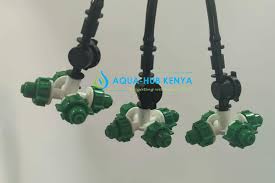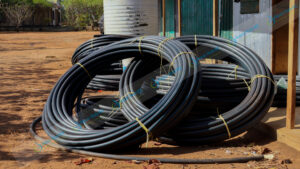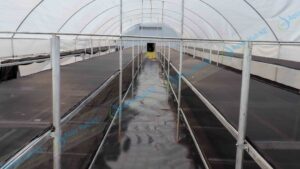Greenhouse farming enhances an optimal Production of crops by offering suitable conditions like temperature, light and humidity. Foggers are used in greenhouse environment for temperature reduction and humidity control.
What is a Fogger?
A fogger is a misting device with 4 nozzles that releases fine sprays of water to the atmosphere above plants. It is commonly used in greenhouse temperature control, pest control in nurseries, and disease control in poultry farming.
Aqua Hub LTD has quality foggers and misters available at affordable prices in Kenya. We engage in supply and installation of other top irrigation systems.
Call 0790719020
How much are Foggers or Misters in Kenya?
From KES 500.
Types of Foggers
High-Pressure Misting Systems: These are the workhorses of greenhouse cooling. A powerful pump forces water through specialized nozzles at pressures typically ranging from 700 to 1500 PSI. This high pressure atomizes the water into incredibly fine, almost invisible droplets that flash evaporate, providing superior cooling and humidification with minimal wetting. They are highly efficient and suitable for large greenhouses and hot climates.
Ultrasonic Foggers: These systems use high-frequency vibrations from a transducer disc to create an ultra-fine mist. They are known for their quiet operation and energy efficiency, making them ideal for smaller greenhouses or specific zones requiring precise humidity without wetting.
Low-Pressure Misting Systems: More affordable and simpler to install, these systems use standard water pressure to create coarser mist. While they offer some cooling and humidification, their larger droplet size means less efficient evaporation and a higher risk of wetting plants, which can be detrimental. They are generally less effective than high-pressure systems for significant temperature drops
How do Foggers Work?
During the hot hours of the day, greenhouses in temperate regions experience extreme heat which may burn the plants. To prevent crop suffocation, foggers and sprayers release mist or fine moisture from near the roof to generate a cooling effect.
Fogger devices work by releasing water in high pressure sprays of 3–5-micron size. The fogger devices have tiny nozzles that make way flow to ooze out as fine mist or fog. This cool mist absorbs heat in the greenhouse environment thereby allowing a drop in temperature.
Fogging systems require a high pressure of 700m head or 70 bar for generation of the mist water release. This pressure is attained with a high-pressure pump in the system.
Benefits of Foggers for Greenhouse Climate Control
Optimal Temperature Control
Foggers, especially high-pressure systems, break water into tiny droplets (5-20 microns). These micro-droplets instantly evaporate, absorbing heat from the air in a process called evaporative cooling. This can significantly reduce greenhouse temperatures, often by 2-3 degrees Celsius for every 10% increase in relative humidity. This direct cooling at the source is far more efficient than traditional ventilation alone.
Optimal Humidity Control
Many crops, particularly those grown in greenhouses, thrive in specific humidity ranges. Foggers allow for precise control, preventing both excessive dryness which can lead to wilting and reduced photosynthesis and excessive humidity which can encourage fungal diseases. The ideal relative humidity for most greenhouse crops is around 80%, with a range of 65-75% at night and around 80% during the day.
Enhanced Plant Health and Yield
By maintaining consistent temperature and humidity, foggers create a stable, stress-free environment. This promotes better physiological conditions for plants, leading to stronger growth, improved flowering, and ultimately, higher yields and better-quality produce.
Reduced Water and Energy Costs
While they might seem counterintuitive, fogger systems are more water-efficient than traditional irrigation for cooling. The tiny droplets evaporate so quickly that they minimize wetting of plant foliage and surfaces, reducing water waste. Additionally, by creating a more uniform climate, they can sometimes reduce the need for excessive ventilation, leading to energy savings.
Pest and Disease Suppression
The maintained humidity levels can make the environment less conducive for certain pest and fungal diseases that thrive in dry conditions. While not a direct pest control method, it contributes to a healthier overall ecosystem within the greenhouse
Components of Fogger Systems
High-Pressure Pump: This is the heart of a high-pressure fogger, generating the force needed for fine atomization.
Nozzles: Choose high-quality nozzles (often brass or stainless steel) designed for fine mist production. Placement is critical for even distribution.
Piping: Use durable piping materials like copper, stainless steel, or reinforced flexible hose that can withstand high pressure.
Water Filtration System: Absolutely crucial in Kenya, where water quality can vary. Filters prevent clogging of nozzles and extend the system’s lifespan.
Control System: This can range from simple timers and thermostats to more sophisticated climate controllers with humidistats and sensors that automatically adjust fogging based on real-time conditions
Difference between Fogging and Misting Systems
Fogging: Produces extremely fine droplets, typically 5-20 microns, which are so light they remain suspended in the air and evaporate almost instantly. This ensures maximum cooling efficiency and minimal wetting of plants. This is what you want for effective evaporative cooling.
Misting: Produces larger droplets, typically 100-200 microns. These droplets are heavier and tend to fall to the ground or settle on plant surfaces, leading to less efficient cooling and potential issues like fungal growth due to excess moisture.
For greenhouse temperature control in Kenya, high-pressure fogging systems are generally superior due to their ability to create the ideal micro-droplets for flash evaporation
What to Consider when choosing Fogging Systems
Greenhouse Size and Layout: Determine the dimensions of your greenhouse to calculate the required fogger capacity and nozzle placement.
Ventilation: Consider your existing ventilation system (natural or mechanical fans). Foggers work synergistically with good airflow to distribute the cool, humid air.
Crop Requirements: Different crops have varying temperature and humidity needs. Tailor your system to your specific plants.
Steps for Installation of Fogger Systems
- Mounting: Securely mount the pump in a dry, accessible location.
- Piping Layout: Strategically run piping throughout the greenhouse, ensuring even spacing of nozzles. Consider suspending lines from the greenhouse structure.
- Nozzle Placement: Position nozzles to ensure uniform coverage and avoid direct spraying onto plants. Aim for a mist that can easily evaporate before settling.
- Water Connection: Connect the system to a clean water source, always use a robust filtration system.
- Electrical Connections: Ensure proper electrical connections for the pump and control system, adhering to safety standards.
- Sensor Placement: If using automated controls, place temperature and humidity sensors at plant level and in areas representative of the greenhouse climate.





